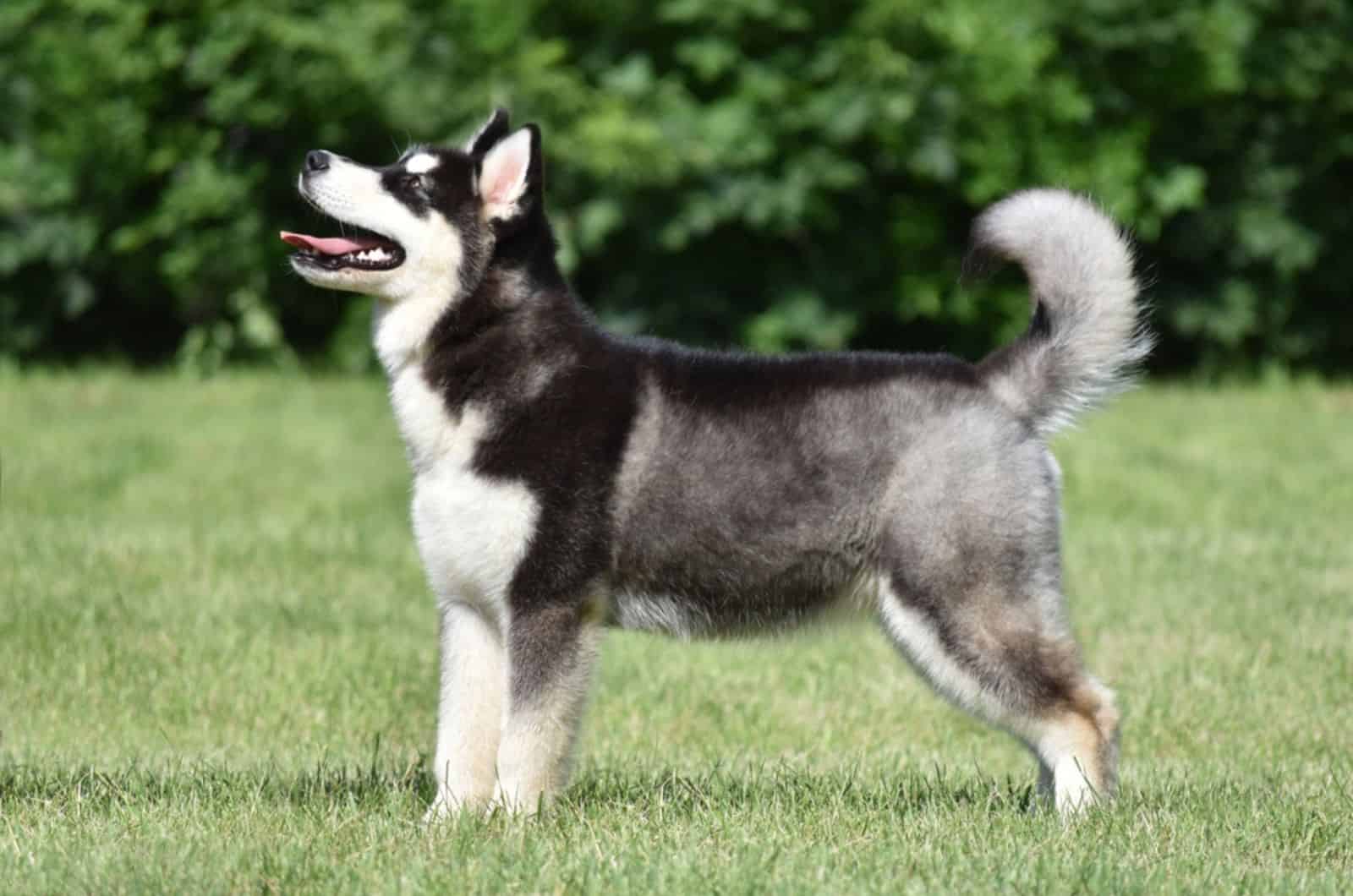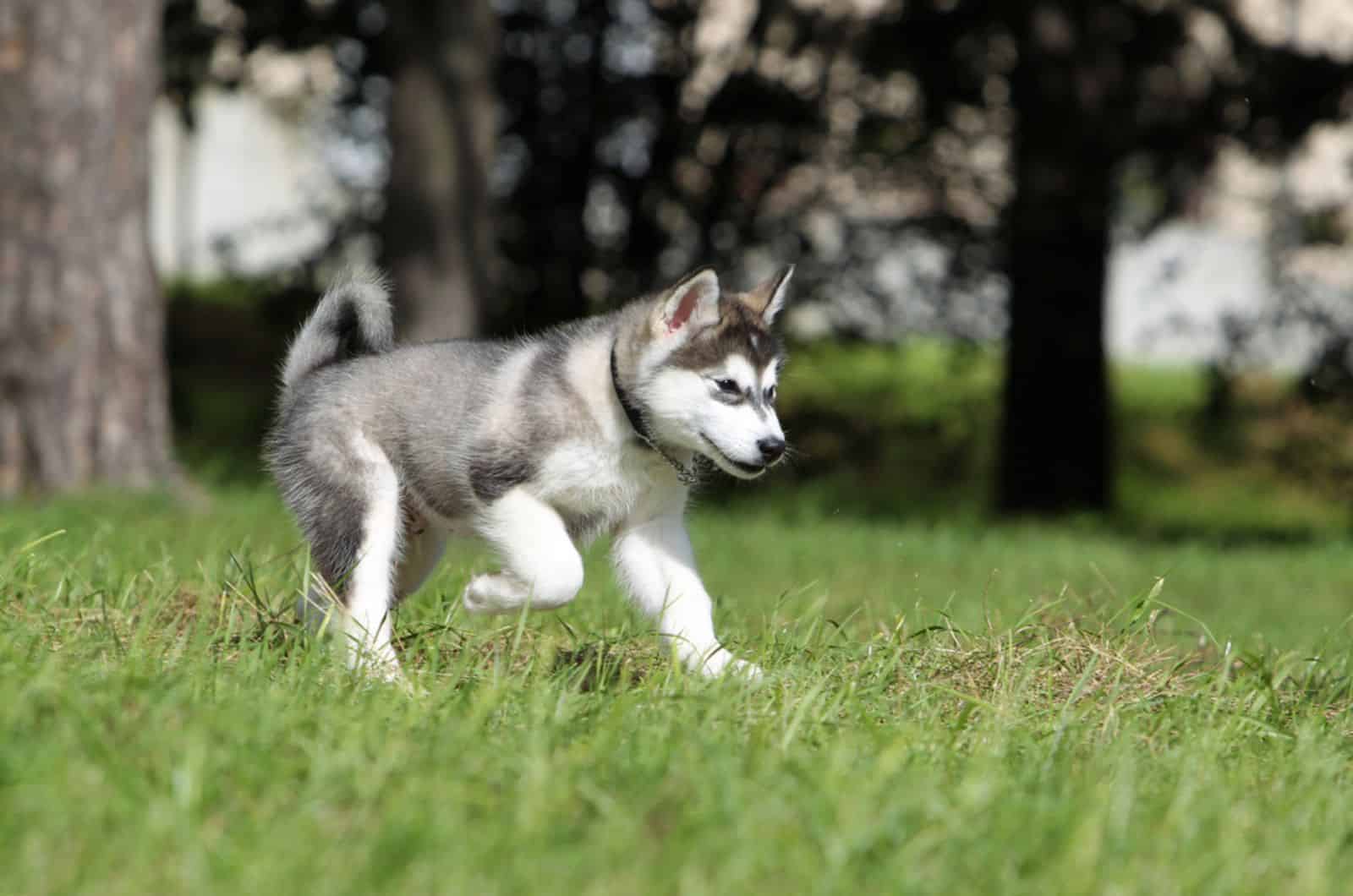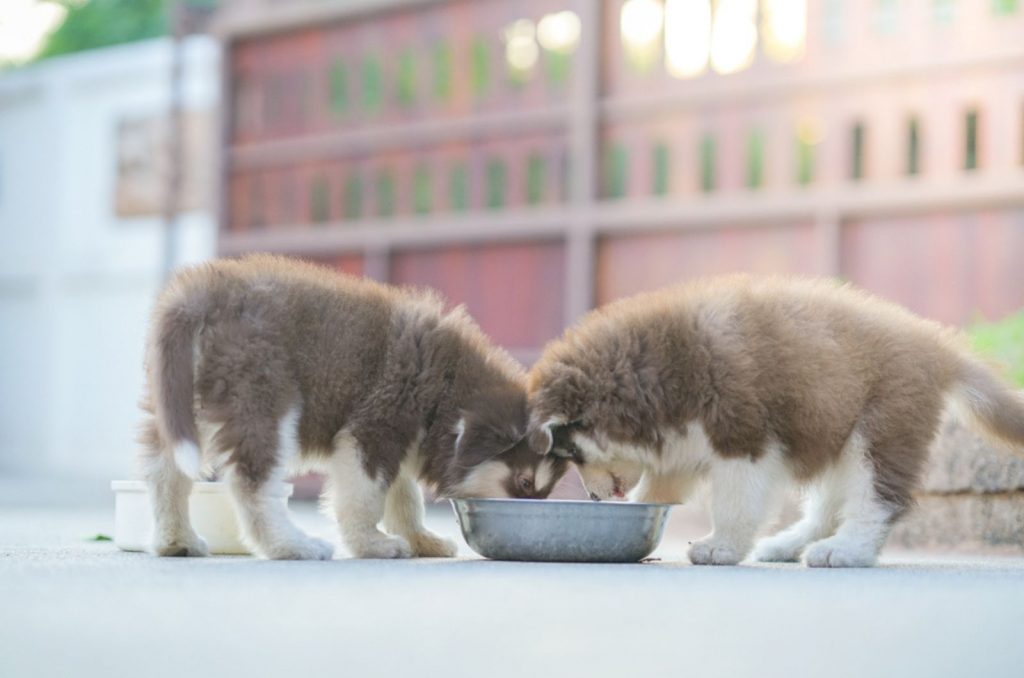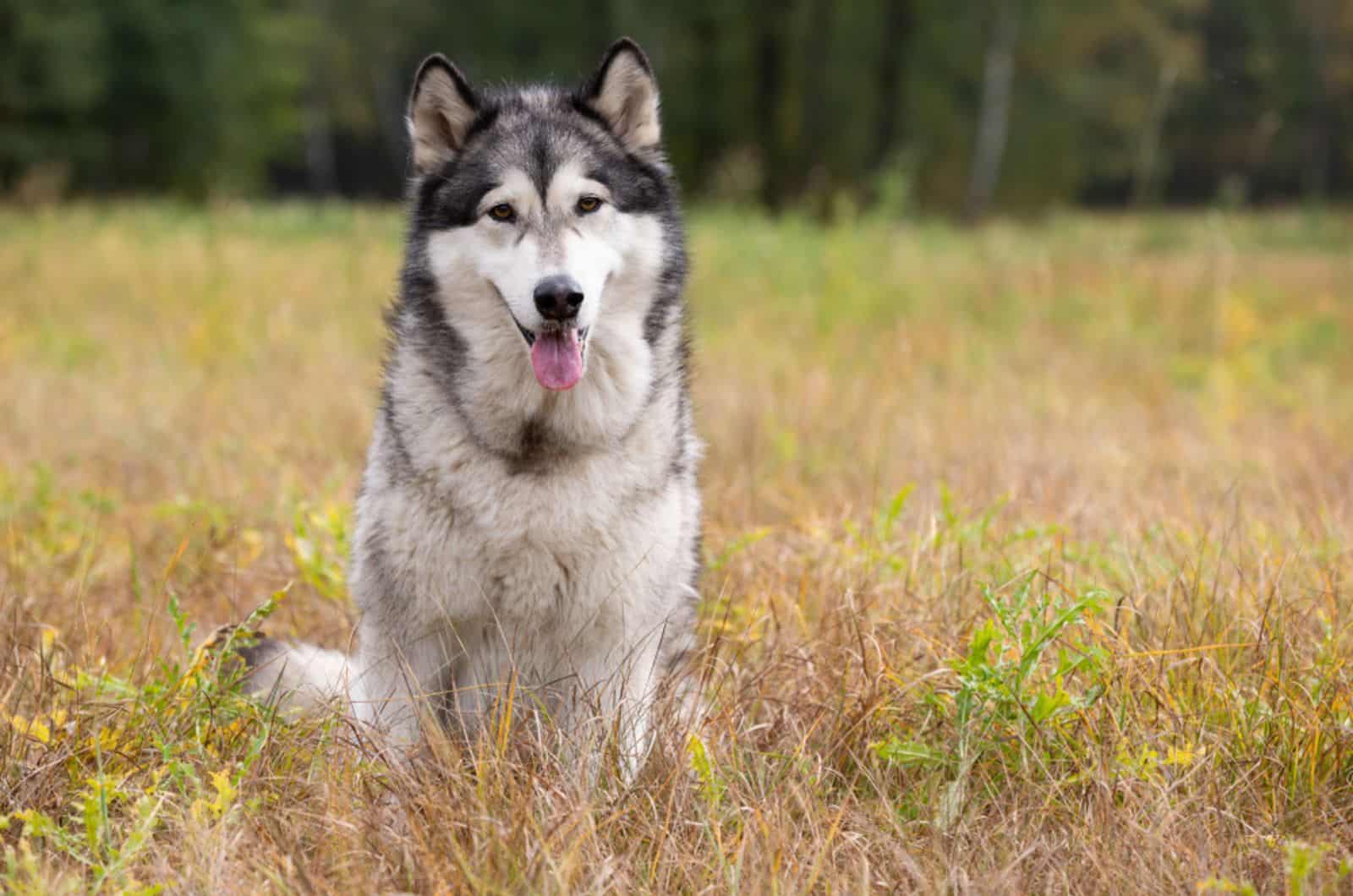If you have an Alaskan Malamute puppy, you might be curious about the average size and weight of these dogs as well as their growth rate.
We’ve created an Alaskan Malamute growth chart that categorizes their anticipated weight by age to assist you in tracking their development.
The Alaskan Malamute has a strong, solid body that was made for endurance and strength. It holds the title of being one of the oldest canine breeds whose original appearance has not undergone considerable change.
While it is often mistaken for the Siberian Husky, this purebred dog is actually quite different.
For this bright dog to avoid getting bored or difficult to handle, it requires consistent leadership.
These sensitive, but large dogs require a lot of interaction as well as space to roam. They are not suitable for apartment living, and they are high-shedding dogs who require a lot of grooming to maintain the health of their coats.
With an experienced pet parent, plenty of room to run around and burn off energy, and a cooler temperature, an Alaskan Malamute will thrive. If you can provide for the demands of this breed, you’ll have a loving, highly-trainable, and clever friend for life.
However, this is not a post about taking care of a Malamute, this is about their size. So let’s get started talking about the Alaskan Malamute growth chart.
Alaskan Malamute Growth Chart
| Dog age | Weight |
|---|---|
| 1 month | 5 to 10 pounds |
| 2 months | 10 to 25 pounds |
| 3 months | 15 to 30 pounds |
| 4 months | 25 to 40 pounds |
| 5 months | 30 to 50 pounds |
| 6 months | 45 to 60 pounds |
| 7 months | 50 to 65 pounds |
| 8 months | 55 to 70 pounds |
| 9 months | 55 to 70 pounds |
| 10 months | 60 to 75 pounds |
| 11 months | 65 to 75 pounds |
| 12 months | 70 to 80 pounds |
| 2 years | 75 to 85 pounds |
| Dog age | Height |
|---|---|
| 3 months | 18 to 20 inches |
| 6 months | 21 to 23 inches |
| 12 months | 23 to 25 inches |
| 2 years | 23 to 25 inches |
Key Questions About Alaskan Malamute Growth

Please be aware that while the height and weight charts listed above represent the typical weight and height of an Alaskan Malamute per month, your pup may develop at a little quicker or slower rate.
Every puppy is different and will grow to maturity at its own pace.
Ask your veterinarian for specific guidance if you are worried about the size of this wolf-like dog.
Now that we’ve got the data and the stats out of the way, we can get into a little bit more detail. The first thing we are going to do is answer three questions about the size of Alaskan Malamutes.
These questions might seem a bit obvious, but it’s still important to answer them and give ourselves a good foundation to build on.
How Big Do Alaskan Malamutes Get?
An average male Alaskan Malamute weighs about 85 pounds and measures about 25 inches in at the shoulder, according to the American Kennel Club‘s official breed standards.
Female Alaskan Malamutes normally weigh around 75 pounds and are 23 inches tall.
So as you can see, females are slightly smaller than the males of this breed.
A purebred Alaskan Malamute will have a powerful build, deep chest, and substantial bones that reflect their history as ferocious Arctic sled dogs.
When Do Alaskan Malamutes Stop Growing?
Most Alaskan Malamutes, as well as some of their mixes, reach their peak growth between the ages of 18 and 24 months.
Around the time of their first birthday, you may anticipate your dog to be near to their full height and weight, but most dogs continue to put on muscle and fill out their chests until they are close to two years old.
It is true that smaller dogs stop growing earlier—some tiny breeds are finished growing even before their first birthday—while large and giant breeds continue to grow up until their second birthday. The Alaskan Malamute, a huge dog, will likewise keep growing beyond his first birthday.
As is the case with all puppies, the growth trajectory is highest during the first six months of age. Thereafter, the growth substantially decreases until the dog is 12 months old, and then it tapers down for the next six to twelve months.
Are There Different Sizes of Alaskan Malamute?
One of the oldest breeds of domesticated dogs, Alaskan Malamutes come in a variety of strains and colors that are included in the breed category.
Kotzebue, M’Loot, and Hinman are three of the most well-known, but there are no obvious distinctions in their adult sizes.
These dogs have been intentionally developed to grow larger in order to carry greater weights. There are those 100-pound Mals that are referred to as Giant Alaskan Malamutes and can tow a mind-blowing 1,000 pounds!
Giant Mals are still employed as sports companion dogs, but because of their size and high exercise requirements, they are not frequently kept as pets.
As is typical with larger, working dogs, male and female Mals differ in size to some extent. However, there is greater variety in their weight than in their height, with males sometimes weighing closer to 100 pounds, while the upper limit for females is usually 85 pounds.
Males typically take a little longer to mature because of this.
The Key Developmental Stages Of Alaskan Malamute Puppies

Sure, you can easily consult the straightforward but useful height and weight tables above to determine the size of your Alaskan Malamute puppy at any given age.
But what if you need more details? What if you’re interested in learning more about their growth at specific stages of their puppyhood?
Undoubtedly, the majority of owners want to know what to expect during these phases, how to prepare for it, and when puppies start to get easier.
That’s why we wanted to talk about that, as well.
The sections that follow are a breakdown of the major physical and psychological changes that occur in the Malamute puppy’s body over the course of its first twelve months of growth, and how it relates to puppy weight.
From Birth To Two Weeks
Your puppy is in the neonatal stage at this time, during which time it cannot walk, hear, see, or smell. They eat and sleep most of the time, and require practically no human attention.
The puppy is totally dependent on the mother’s milk during this time for sustenance.
They rely on their mother to assist them to urinate and defecate because, as well, and she does this by licking their stomachs. Because they are unable to regulate their own body temperature, they also rely on their mother to keep them warm.
From Two Weeks To Three Months
During this stage of transition and socialization, the Alaskan Malamute begins to view everyone in their environment as a member of their family.
Your Alaskan Malamute puppy will go through a lot of changes at this stage, including weaning and the switch from liquid to solid food. If they receive the right nourishment, they will continue to grow quickly.
At this age, when nutrition is extremely crucial, the switch from milk to solid meals may have an impact on how healthy they will be for the rest of their lives.
You can now begin teaching them fundamental skills like going potty, showing obedience, and leash walking. This is due to the fact that they are still highly curious and respond positively to praise.
It is crucial that you socialize them with other dogs and people as well as gradually expose them to the outside world.
From Three Months To Nine Months

Their puppy body and face start to resemble an adult Alaskan Malamute during this adolescent era.
Your puppy is still young, and patience is needed because of how curious and active he is. It is currently figuring out their place in the group, so you need to establish yourself as the dominant pack leader.
Your puppy is more eager to learn now, so you can start more advanced training.
From Nine Months To 18 Months
Your puppy is now physically and sexually mature, making this the ideal time for mating if you choose to breed it. If not, it’s also probably the best time to go forward with the spaying or neutering procedure. More on that later.
Your puppy might now be looking for experiences and begin going on hunts in the backyard for a sense of accomplishment.
Because they are so busy and spirited at this age, mental stimulation is necessary. The time is now for you to get them some challenging toys and show them some tricks.
To keep them occupied, you might expose them to easy sports that aren’t too strenuous on their bodies.
Adult Alaskan Malamute
Now that your puppy is a grownup, it’s time to take long walks and allow them to experience their surroundings in the fullest sense. These dogs just need family care, a regular schedule, stability, enjoyment, and predictability.
They are more dependable on walks and like to identify their area by scent.
The majority of Alaskan Malamutes put on weight at this period, so it’s important to keep them active frequently and keep treats to a minimum.
By this point, your dog should be fully developed physically and be set on its adult weight and height.
An average male Alaskan Malamute measures 25 inches at the shoulder and weighs about 85 pounds. Typically, female Alaskan Malamutes stand 23 inches in height and weigh roughly 75 pounds.
Factors That Impact Alaskan Malamute Growth

Each adult Alaskan Malamute dog can be a different size. Even though this is rather obvious, the listed values in the Alaskan Malamute growth chart are actually height and weight ranges, rather than single amounts.
This is supposed to account for the fact that some puppies will be bigger than others and vice versa. But why exactly is it the case?
Why do some Malamute puppies grow to be smaller than others, and what variables affect their size as they mature?
There are numerous contributing factors, and in the end, there is a complicated web of causation that is difficult to distinguish from one another. However, we can state with certainty that some of those factors are more important than others.
So let’s talk more about those in particular.
Genetics
The parents of your dog will have some genetic impact on it. This is why it’s a good idea to ask your breeder who your puppy’s biological parents are.
In general, if the Alaskan Malamute parents were larger dogs themselves, there is a good chance that the puppies will be large as well. On the other hand, if the parents were closer to the smaller end of the size range, their pups would likely be a little bit smaller.
While there are obviously no guarantees and it’s possible that there will be exceptions, it’s still a good general rule to have. In particular, because Mals are purebred, determining their size is easier than it is for puppies of mixed breeds.
There are simply more variations in mixed breeds due to their complex backgrounds.
Gender
Growth is influenced by gender, as is probably clear from the Alaskan Malamute growth chart itself.
A typical male Alaskan Malamute weighs about 85 pounds and measures 25 inches at the shoulder. Female Alaskan Malamutes typically stand 23 inches tall and weigh around 75 pounds.
There is also a difference in their growth rate, as females normally mature sooner than males, partly due to their somewhat smaller bodies.
Later on, there can be more gender-based weight differences.
For instance, the weight of your female Mal will alter considerably as she gets pregnant and gives birth to puppies. Additionally, she can experience puppy blues, which might have an impact on how much she eats and weighs.
Similarly, if you get your male Alaskan Malamute neutered, the procedure and subsequent rehabilitation process might affect his appetite and impact his weight.
Speaking of appetite and weight…
Diet

Depending on its age, your Alaskan Malamute has to be fed a high-quality diet in the proper quantities.
Overfeeding a puppy can result in obesity, which shortens a puppy’s life and poses major health risks.
Overweight puppies are more prone to developing joint issues including hip and elbow dysplasia. Surgery and pricey medication may be required for this.
Give your Alaskan Malamute a serving of premium dog food with moderate amounts of protein as the main component. They are a huge dog breed and should develop higher muscle mass, therefore protein consumption is significant.
Make sure the food is of the proper quality and amount, and try not to cave into your dog’s pleas for treats. Dogs who eat treats over regular food can develop serious health conditions.
Exercise
If diet is the yin, then exercise is the yang, at least when it comes to maintaining a healthy weight in an Alaskan Malamute.
To develop properly and realize their full potential, they require a lot of activity. To avoid damaging your puppy’s growth plates, make sure the exercise you offer them is appropriate for their age and size.
Simple walks are always a good option.
Paw Size
Okay, this isn’t exactly a factor that impacts the growth of an Alaskan Malamute, but we’ve decided to put it in here because it can be a great indicator.
Check the size of your Malamute puppy’s paws. They may still be filling out and developing if they appear to have big paws in comparison to their legs and bodies.
Read next: Top 7 Reputable Alaskan Malamute Breeders In The U.S.
Health
As we’ve already said, there are a number of congenital medical disorders that might affect a dog’s growth, such as hip dysplasia.
However, there are other health conditions that manifest gradually during a dog’s life and hinder or restrict the development of the animal in some way.
On the other hand, your dog may occasionally face risk from health problems related to Malamute weight.
Does Spaying Or Neutering Your Alaskan Malamute Affect Its Growth?
If you choose to neuter your male Alaskan Malamute, the best time to do it is probably after their adolescent stage, meaning between the ages of nine and twelve months.
Doing it before this period might cut off the supply of testosterone, which is a hormone that is vital in the growth of bones and muscles.
When it comes to female Alaskan Malamutes, the generally suggested time for spaying is after they have had their first heat cycle, but before they’ve gotten pregnant with a litter.
There are, of course, debates among dog owners on when exactly is the best time to neuter dogs and whether it should be done at all. That’s why you should always have a conversation with your vet and figure out the best course of action for you and your pet.
Why Do I Need An Alaskan Malamute Growth Chart?

Observing a puppy’s growth during that crucial early stage is one of the most important components of dog ownership. Given that they are huge dogs, Alaskan Malamutes can be a handful, and they need to be provided with all the conditions they need to thrive.
You may monitor your puppy’s growth and make sure that its weight and height are increasing adequately by using our Alaskan Malamute growth chart as a type of height and weight tracker.
Not to mention all the other factors that require your attention, such as the food, level of activity, training, etc. Knowing how big and how heavy your Alaskan Malamute should be at a certain age will help you plan its diet and living arrangements.
In the broadest of senses, the size chart will help you make sure that your Alaskan Malamute doesn’t get obese or underweight.
Measuring The Height Of An Alaskan Malamute
The height of a dog is calculated from the ground to the withers.
Make sure your dog is standing straight before laying the measuring tape on the ground and moving it straight up toward the withers.
If you want more details on how to accurately measure your dog, we have an in-depth article about that topic here.
Measuring The Weight Of An Alaskan Malamute
If you want to make sure that your dog is developing as anticipated, regular weighing is vital.
You can keep track of its weight over the course of its life as a great way to ensure its health.
There are two techniques to calculate your Alaskan Malamute’s mass. The first method is really simple and only calls for you to put your dog on a scale.
If for some reason your dog is unable to stand alone on a scale, you can climb on it while holding your pet, record the weight, and then subtract your own weight from it.
We do recognize the fact that the Alaskan Malamute is a pretty big dog — to say the least — and this method may not be as useful once it gets to a certain age.
You might consider taking it to the vet’s office because they tend to have those big scales that are more practical for measuring a dog’s weight.
Conclusion
The Alaskan Malamute is a fascinating dog breed, and its size is just one aspect of that. Even if you may have a strong preference for this breed, there are some things you need to keep in mind if you wish to bring one into your home.
This Alaskan Malamute growth chart is a helpful tool that can help you stay on top of its development by regularly keeping track of your Mal’s height and weight, thus making sure that its growth is on the right course.
But there are other things to consider, as well.
This breed is exceptionally sensitive and has a strong need for affection and proximity to its family. In addition, they are known to have high activity needs, so you will need to be able to keep up with their standards.
Although this breed does require some work, putting in the time and effort will result in a fun, caring, and affectionate dog that will stay loyal to you for its entire lifespan.
If you do choose to get one, make sure to use our Alaskan Malamute growth chart as a reference point for its growth rate.













